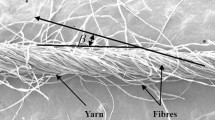Abstract
The ring spinning method is broadly used for manufacturing various forms of yarns in various application fields in thanks of the outstanding yarn characteristics and the well established processing technology. However, applying the ring spinning for manufacturing functional yarn, for example, the core-spun yarn, often raises serious yarn quality problems. Especially, surface defects make it difficult to extend the technology to various end-purposes. Dynamic state of the tension of fibers in the spinning triangle that is considered as a triangular plane flow field plays an important role in causing the defects. In this study, a theoretical model describing the tension behavior of the fibers in the triangular plane flow field was derived and the availability of the model was tested experimentally. Results showed that the steady-state experiments brought good corresponding results with those from the theory, which identifies the effectiveness of the theoretical model. The tension dynamics of the fibers in spinning triangle could be expressed as a 1st order system, while the spinning triangle length and the process velocity could majorly affect the tension dynamic characteristics.
Similar content being viewed by others
References
W. E. Morton, Text. Res. J., 26, 325 (1956).
G. Riding, J. Text. Inst., 55, T9 (1964).
J. W. S. Hearle, B. S. Gupta, and V. B. Merchant, Text. Res. J., 35, 329 (1965).
Y. Huh, Y. R. Kim, and W. Y. Ryu, Text. Res. J., 71, 81 (2001).
Y. Huh, Y. R. Kim, and W. Y. Ryu, J. Korean Fiber Soc., 41, 237 (2004).
G. F. Ruppenicker, R. J. Harper, A. P. Sawhney, and K. Q. Robert, Text. Res. J., 59, 12 (1989).
A. P. S. Sawhney, K. Q. Robert, and G. F. Ruppenicker, Text. Res. J., 59, 519 (1989).
Ali. A. A. Jeddi, M. S. Johari, and A. A. Merati, J. Text. Inst., 88(part 1), 12 (1997).
O. Babaarslan, Text. Res. J., 71, 367 (2001).
M. Dang, Z. Zhang, and S. Wang, Fiber. Polym., 7, 420 (2006).
C.-L. Su, M.-C. Maa, and H.-Y. Yang, Text. Res. J., 74, 607 (2004).
C.-W. Lou, Text. Res. J., 75, 466 (2005).
C. M. Deng, L. J., Wang, and X. G. Wang, Fiber. Polym., 8, 289 (2007).
Y. Huh and J. S. Kim, Fiber. Polym., 7, 424 (2006).
Author information
Authors and Affiliations
Corresponding author
Rights and permissions
About this article
Cite this article
Huh, Y., Kim, H.J. & Kim, J.S. Tension dynamics of the fibers in a triangular plane flow of bundle. Fibers Polym 9, 349–354 (2008). https://doi.org/10.1007/s12221-008-0056-7
Received:
Revised:
Accepted:
Published:
Issue Date:
DOI: https://doi.org/10.1007/s12221-008-0056-7



